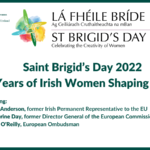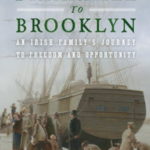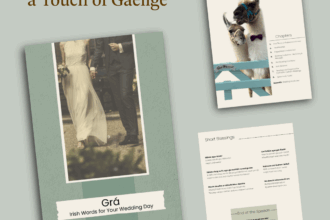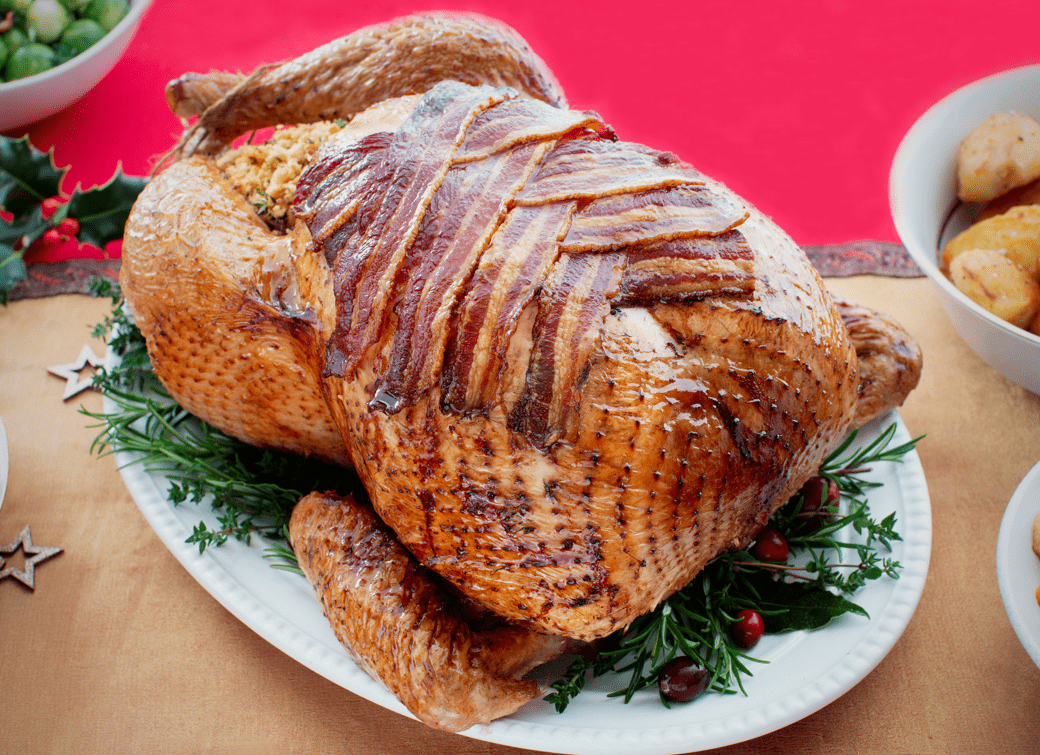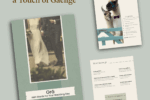The first of February sees the feast day of one of the premier saints in the Irish tradition, Saint Brigid. Brigid is second in line to the more well Known Saint Patrick but evidence points to the fact that she may well have been higher up the scale till the patriarchal Roman Church and its customs eclipsed that of the “Celtic” church. While the historical personage of Patrick can be proved to have existed, the existence of Brigid lies in much murkier waters with no writings surviving from her time. We do however have no shortage of “saints lives” pertaining to Brigid, the earliest of which was written by Cogitosus (the predecessor of Muirchú, Patrick’s biographer) in an attempt to gain primacy for the church of Kildare over Armagh (Brigid over Patrick). The church later reviewed many of the fifth and sixth century Irish saints, demoting a number of them so they were no longer “calendar saints”, that being saints who have a feast day (O’Cathasaigh,1982:76). Brigid and Patrick both survived this cut with Patrick better fitting the patriarchal model of the Roman Church and becoming the premier saint of the country. There is ample proof however that Brigid is most likely a continuation of the earlier goddess Brigid/ Brigantia who was worshipped around the country and beyond. The tutelary Goddess of Leinster became its tutelary saint and prominent Celticists such as Myles Dillon, Nora Chadwick and Prionsios MacCana infer that Brigid is the personification of the Celtic goddess. Synchretism like this is not uncommon, especially in Ireland, where the new faith adopted practices and beliefs of the pagans in order to ease the conversion. Because of this the saint took on many of the attributes of the earlier Goddess. It is no coincidence either that her feast day coincides with the ancient festival of Imbolc, the start of spring in the ancient Irish calendar. In this article I will be looking at the saint and of course some of the plethora of traditions that are associated with Saint Brigid’s day.
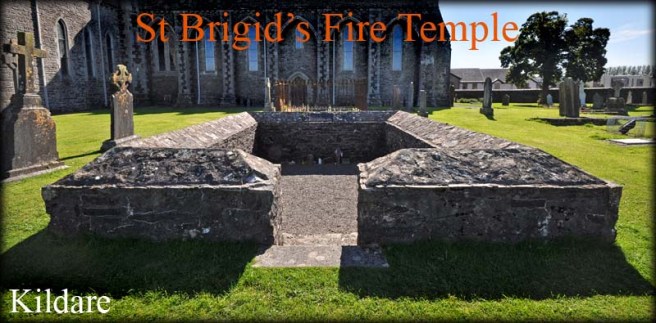
Brigid is traditionally said to have been the abbess of a monastery in Kildare where her and her nuns tended a perpetual fire, recorded as a perpetual “ashless fire” according to Geraldus Cambrensis in 1196 (O’Cathasaigh,1982:82). Liminality is a recurrent theme with the character of Brigid. Born at a liminal time in a liminal place, She is said to have been born on the threshold of a door (neither within or without the house) and at the breaking of dawn (neither day or night). This liminality can also be seen in her association with a red-eared white cow, an animal always associated with the otherworld and the Daoine Sídhe (fairies). Until fairly recently the cult of the saint remained relatively intact across the country but with some various regional differences (O’Cathasaigh,1982:87). Sean O Suilleabhain, the archivist of the National Folklore Collection, recorded many pilgrimages to holy wells, sacred streams and ruins for the saint. The biggest of these is to a shrine in the townland of Faughart, Co. Louth (the supposed birthplace of the saint). Here the cult of the saint still survives and flourishes to this day. Also in Faughart there was mention of the ruins of an ancient church to be found in The Ordnance Survey Letters (1836). The church is mentioned as “Teampull Brighde Na hAirde” and also mentioned is “Brigid’s Stone”. The stone is most likely the base of a high cross. What is interesting is that the hill has much earlier pagan associations with megalithic tombs, souterrains, and raths in the area (O’Cathasaigh,1982:90). Also to be found in the area are rag bushes with many offerings left at them.
As well as Brigid’s Stone there are also a number of other stones associated with her. Stones in the area feature marks that tell of a story when she tried to escape a suitor and plucked out one of her eyes to make herself less attractive. The marks on these stones recount every movement of the saint throughout this tale and go by names such as the headstone, hoof-mark stone, the waist stone and the eye stone (the one that healed the eye she had taken out). The etiological tales (i.e tales explaining the origin of something, especially unusual features of the landscape) explaining the marks on stones are plentiful throughout the country (such marks are not unique to Ireland and can be found elsewhere (cf. the knee marks of saint Peter and Paul outside the church of saint Francis in Rome where they prayed to defeat the magician Simon Magus). Due to the durability and impenetrability of stone these marks are often attributed to supernatural or superhuman characters as they alone are capable of changing the surface of the stones by touching them. These marks are often found attributed to otherworldly women or heroes when found on standing stones and are frequently attributed to saints from the early Celtic church such as the case above with Brigid (oftentimes to emphasise the power of the new faith), when dealing with the hollows of ballaun stones and such. Early saints often left marks on boulders from knees, hands heads etc. This tradition is especially prevalent in Leinster where the stones are often called Gloonan stones (stemming from the Irish word Glúin for knee). Tradition holds that many of the depressions of these stones hold curative powers when the accumulated water gathered from the hollows is used. (Zucchelli,2016: 90).
The feast/ festival and its traditions
As with many important feasts and festivals in the Irish calendar, the eve of the festival is just as crucial, if not more so, than the day itself. The traditions of the feast have been recorded in both the National Folklore Collection (hereafter NFC) and the Schools Collection (hereafter NFSC) with others extant to this day.
A sod or two was often turned in a tillage field. Wind direction on the eve of the festival was carefully noted as the prevailing wind during the coming year. The day of the festival itself should show signs of improving weather but if it was too good it was an omen of bad weather to come. In some areas, especially in parishes dedicated to the saint, only work that was strictly necessary was carried out and in some areas of Kerry and west Cork any kind of work that involved the turning of wheels was avoided. In other regions both ploughing and smithwork fell under this ban.
Also, on the eve of the festival (31st Jan), called Brídeóg Night in some areas, the children of

the district went out from door to door. They would disguise themselves in old clothes or in their own clothes turned inside out. They would mask their face with pieces of cloth or curtains, sometimes using straw or rush hats to keep the veils on. The Brídeóg, called miss biddy in this instance, was a doll made from old rags or a butter churn dressed up. The person recounting this tale mentions that in this case a turnip was carved and painted with soot. The groups of young people were divided into two groups by age: 8-13 and 13-20. They would play music at each house to receive money or sweets (NFSC,Vol.0126:270). A rhyme of some description was said as the door was answered. This again varied to some degree by district but was fundamentally the same. In Leckanvy, Co. Mayo the rhyme went as follows:
“Here comes poor Brigid both deaf and blind,
Put your hand in your pocket and give her a coin
If you haven’t a penny, a half penny will do
If you haven’t a halfpenny god bless you”
(NFSC,VOL.1038:107)
Probably one of the most recognisable traditions of Saint Brigid’s feast is the “Brigid’s cross”.
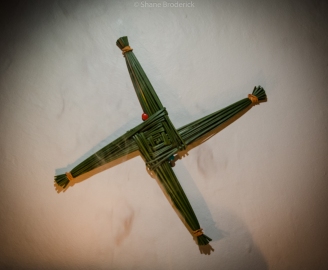
These were and still are traditionally made from either reeds or straw. These were prepared on the eve of the feast in a highly ritualised manner. Depending on the region these vary in complexity. The simplest resembling the characteristic four armed Brigids cross (some 3 legged varieties are to be found in the north and the more complex containing up to 30 lozenges, crosspieces or lattices. These diamond or lozenge crosses are found in all provinces but are most commonly found in Connaught and Munster (O’Danaher, 1972:16).On St Brigid’s Eve a member of the family would gather rushes and leave them at the door. At nightfall a member of the family would go outside and call to the people in the house to let Brigid in. They all shout a welcome while on their knees and this is repeated 3 times. The family then made crosses from the rushes and the following day holy water was sprinkled on them. The crosses are thought to protect against lightning, fire and protect animals from diseases (NFSC,Vol.1048:197). T.G.F Paterson recorded that in 1955 in Armagh that the custom of making crosses was dying out. He also mentions that the reeds for the crosses were to be pulled and on no account cut. The household had a special meal that evening (called Brigid’s tea/supper) featuring pancakes (Paterson,1955:17). A sheaf of oats or cake was thrown at the door to vanquish hunger but a second was left outside for the saint or a hungry traveller. An abundance of butter and milk could be found on the table (Cathasaigh,1982:88). In times gone by there were no ceilings inside the houses so it was common to attach the crosses to the inner side of the thatch with new ones being added year after year. When they could be no longer preserved they should under no circumstances be thrown away. They were to be either buried (to bestow a blessing on the crops) or burned in the fire. Giving them as gifts was said to put a blessing on the maker and their welfare was increased by the gift of bestowal and friendships would be strengthened in the donor and recipient (Paterson,1955:18). One of the earliest references to the cross is from a poem from 1735 that illustrates the power that the crosses were said to have. The poem goes as follows:
“St Brigid’s cross hung over door
Which did the house from fire secure
O Gillo thought, O powerfull charm
To keep a house from taking harm;
And tho’ the dogs and servants slept,
By Brigid’s care the house was kept.”
This belief in the protection against fire, and also lightning, still persists today. It was also believe that they had the ability to ward off disease and that evil spirits were unable to enter the house while they were hung over the door. In some districts rushlights were made from the excess and lit in honour of the saint while in parts of Antrim a tradition was recorded where the excess rushes were fashioned into a ring and hung on the spinning wheel to bring a blessing on its work for the coming year (Danaher, 1972:18).
Some other traditions, recorded by Nuala McGinty, in the Schools collection are that every person working at sea take their clothes outside and shake them saying “Bratóg Bríde”. No one should go outside after dark and as well as making crosses people tie wreaths around their head to prevent headaches for the year. They kneel and pray while asking her to come in. They say the rosary after making the crosses (NFSC,Vol.1083:56).
Yet another common practice spanning many regions is the of Brat Bríde. This practice involves leaving a piece of

cloth or ribbon outside before dawn to collect dew. This was carefully kept aside (as it was believed to have curative powers). The brat, often a tie, belt or braces were left out and worn by men whenever they engaged in any dangerous work for protection. The ribbon would be hung on the door so the saint would touch it or left outside. It was particularly useful against pains in the head such as headache, earache or toothache (O’Danaher,1972:33)
In her book Festival of Lughnasa, Maire MacNeill says that St Brigid’s feast as well as that of Bealtine and Samhain are feasts that can be held in the dwelling place. They are important to the social unit of the household. In the case of Brigid, there is much effort in preparing the household and there is a high level/ atmosphere of expectation on the eve of the feast. A symbolic extra place might be set for the visiting saint or a bed of straw made. Ashes are smoothed over and made flat and surrounded by a rolled up cloth to stop them being disturbed by wind. They are inspected in the morning to look for the marks of the wand of bride or especially the footprints. The footprints meant that Brigid was there overnight and they, the household, were especially favoured. They could expect an increase in their household, field, crops or flock. If there was no sign it was seen that they had offended her and they would burn incense and offer an oblation. This oblation was generally a cockerel buried alive at a junction of three streams (O’ Catháin,1992:8). Scholarship strongly implies that the goddess Brigid functioned as a household protector (O’Cathasigh,1982:72). This also seems to point to Christian-pagan synchronism and can be seen in the prayer to the saint to protect house when banking down the fire at night.
These are not by any means an exhaustive list of the traditions associated with the saint and her feast but I hope they illustrate the importance of the festival in the Irish calendar. Thank you for taking the time to read and I hope it kept your interest. Feel free to comment and share.
Bibliography
NFSC, Vol.0126:270, Collector: Rita Cunney, corrower, Mayo,Informant:Mr +Mrs Cunney, Corrower, Co.Mayo
NFSC,Vol>1048:197,Informant Hugh Melly(70), tullycleave, Ardara.
Ó Catháin.S, Hearth-Prayers and Other Traditions of Brigit: Celtic Goddess and Holy Woman, The Journal of the Royal Society of Antiquaries of Ireland, Vol. 122 (1992), pp. 12-34.
O’Cathasaigh, Donal. “The Cult of Brigid: A Study of Pagan-Christian Syncretism in Ireland.” In Mother Worship: Theme and Variations. Ed. James J. Preston. Chapel Hill, NC: University of North Carolina Press, 1982.
Paterson.T.G.F, Harvest knots and Brigids Crosses,ULSTER FOLKLIFE 1955.
Zucchelli.C (2016), Sacred Stones of Ireland, Collins press.
Danaher.K (1976), The Year in Ireland, mercier press
Source: Irish Folklore


